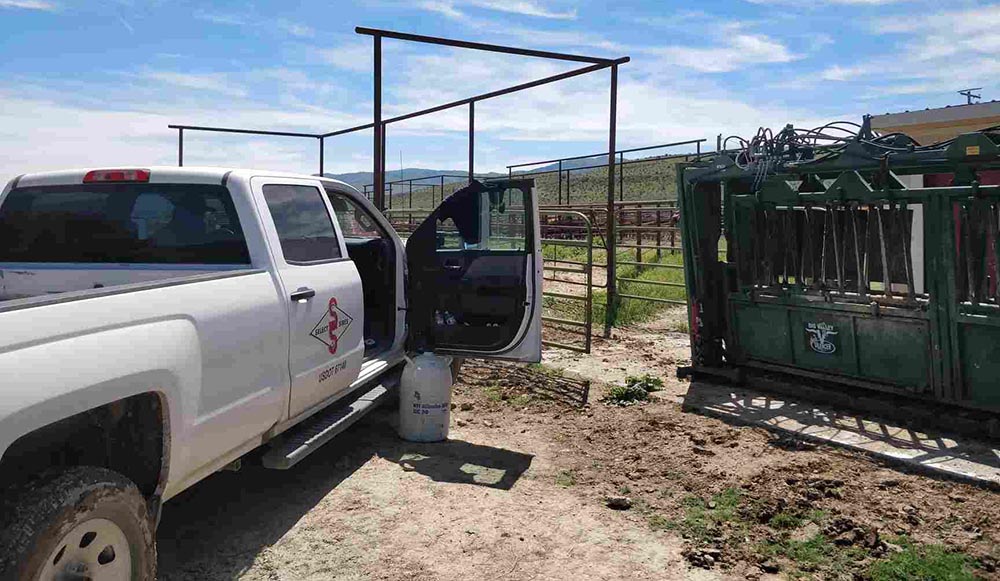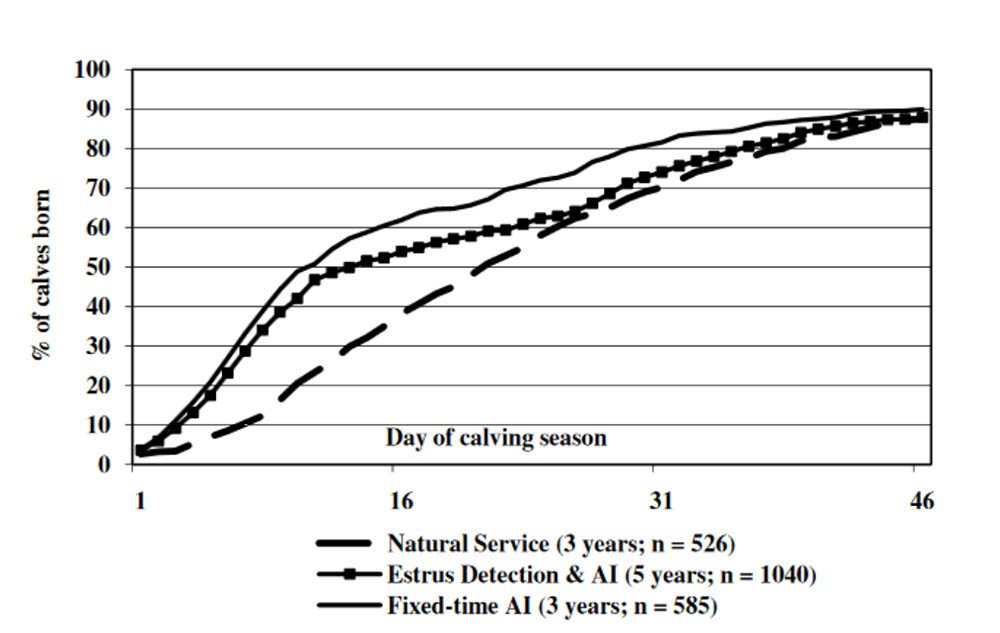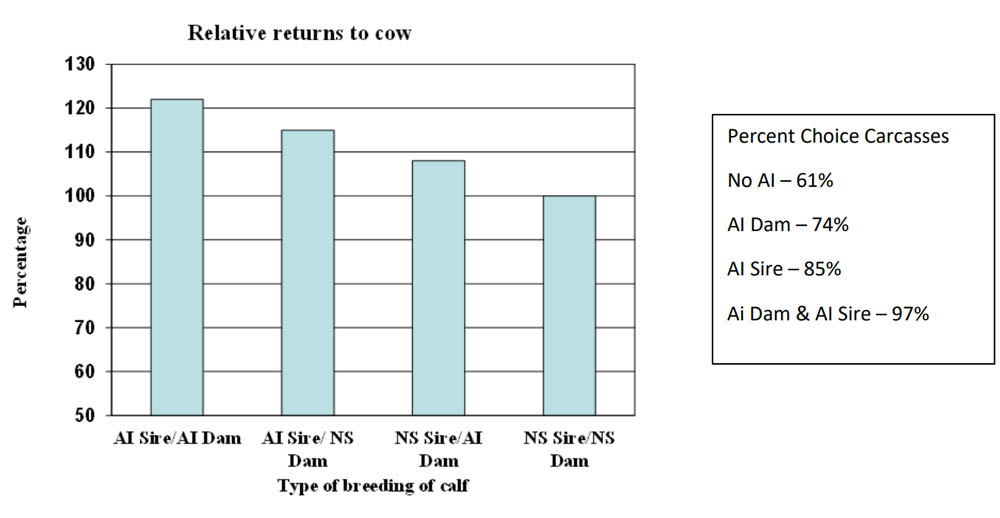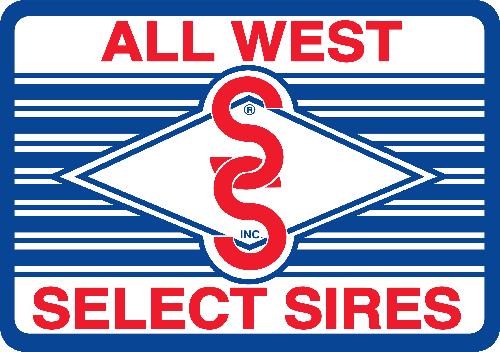
John B. Hall, Ph.D., Extension Beef Specialist, University of Idaho
Fixed-Time AI makes artificial insemination logistically feasible in commercial beef operations. We have examined several opportunities to capture value with AI in commercial beef operations. Each operation needs to conduct their own analysis. However, AI can be economically beneficial to the operation if value can be captured in one or more areas.
When will AI Pay in a commercial operation?
First When……
• Management of nutrition and health are already good so the probability of acceptable pregnancy rates to AI is high.
• Estrus synchronization protocols are followed carefully.
Next by capturing AI value (with one or more opportunities) when…..
• Calving distribution is shifted earlier in the calving season and high growth sires are used.
• A portion of the herd is mated to terminal sires.
• Heifers calve earlier in the calving season resulting in greater longevity and lifetime productivity.
• Maternal heterosis is captured through generating crossbred dams.
• Increased carcass value is realized through retained ownership.
Artificial insemination (AI) of dairy cattle started in the late 1930’s becoming more common place by the 1940’s. By the 1950’s, frozen semen became available. Today, in the US, over 66% of dairy cows are bred AI and over 85% of registered Holsteins are products of AI. However, only 7.9% of US beef operations use estrous synchronization and 7.6% of operations use AI resulting in less than 10% of US beef females receiving AI (NAHMS, 2009). In addition, a majority of the AI in US beef herds is in the seedstock sector.
So why did AI take off in commercial dairy operations, but still has not gained traction in commercial beef herds? For any technology to be adopted, it must be effective, fit into the management of the operation, and provide sufficient return on investment. For dairies, AI fit into the management system – twice daily milking and heat detection fit together. Removing the hassle and danger of hand mating dairy bulls to lactating dairy cows was a welcome change. Finally, it was easy to see the results of AI. Over the last 50 years, the increase in milk production per cow per year averaged 266 lbs. with 150 lbs. attributed to genetics. It was easy to see the impact of AI in the milk check. For commercial beef herds, capitalizing on the value of AI had been more difficult to obtain and perceive. The impact of AI for commercial operations will be the focus of this presentation.
New Systems Make AI Workable in Commercial Beef Operations
Time and labor are the primary reasons producers indicate as a barrier to adoption of AI in commercial beef cows and heifers (NAHMS, 1998). Advances in fixed-time AI (FTAI) systems for beef cattle resulted in systems that reduce cattle handling and time associated with AI while producing consistent results of AI pregnancy rates from 50% to 65%. For example, Missouri researcher conducted on ranch demonstrations where the inseminated 7028 cows in 73 herds across the state. Average pregnancy rates to AI in cows synchronized with the CO-Synch + CIDR protocol was 62% with only 7 herds having a pregnancy rate below 50%. Pregnancy rates to FTAI for the last 6 years in the UI herd at the Nancy M. Cummings research station are shown in Table 1.
Table 1. Pregnancy rates to fixed-timed AI from 2014-2019 Nancy M. Cummings REEC Herd
| Female | Semen Type | AI Pregnancy rate | Range |
| Heifers | Conventional | 61.9 % (234/378) | 57.6% – 70.2% |
| Heifers | Sexed | 48.4 % (200/413) | 26.8% – 72.5% |
| Cows | Conventional | 54.6% (976/1789) | 38.7% – 62.6% |
These pregnancy rates were achieved during research on modifying estrus synchronization systems; therefore, pregnancy rates were not optimized, but probably reflect what is typical in commercial operations.
Opportunities to Capture AI Value
Most cow-calf operations market feeder calves whereas an increasing number are retaining ownership through harvest. Retention of replacement females is also an important segment of the cow-calf enterprise. Generating replacement heifers for sale is another alternative income stream. There is some potential for reduction in breeding costs. All of these areas offer opportunity for capitalizing on AI. In each case, return to cow exposed is the critical economic indicator.
Increasing Value of the Feeder Calf
The greatest opportunity for most cow-calf operations to capitalize on incorporation of estrus synchronization and AI is by increasing the value of the feeder calf. Research from Missouri and Florida as well as other universities clearly indicates that one of the benefits of FTAI is having a greater percentage of the calves born in the first 21 to 30 days of the calving season. Figure 1. illustrates the change in calving distribution realize when moving from natural service to a combination of FTAI and clean-up natural service. Increased age at weaning of calves, improved pregnancy rates, and the potential for increased growth due to improved genetics results in reported weaning weight increases of 20 to 40 lbs for the entire calf crop (Rodgers et al., 2012).

Figure 1. Impact of incorporating fixed-time AI into the Univ. of Missouri cow herd on calving distribution (Patterson et al., 2006)
The value in shifting the percentage of calves born early in the calving season as a result of using FTAI cannot be underemphasized. Researchers at the University of Florida examined the economic benefit of using FTAI to reduce the length of the calving season and alter the distribution of calves born early in the calving season. They compared two years of a 120-day natural service breeding season to transition to a 70-day breeding season including FTAI in their 300 cow Angus herd. Over the five years of transition, they increased returns to the herd by over $40,000 per year (Lamb, 2015).
Another opportunity that FTAI affords is to use more terminal type genetics. Bulls can be selected for terminal traits with the intent to sell all offspring regardless of sex of calf. A portion of the cows could be bred to these terminal type bulls which would increase weaning weights.
The potential value of a FTAI program in a commercial operation is illustrated in Table 6. Costs are taken from Table 5. The first two columns compare the FTAI program which results in 5% more calves and a 30 lb. increase in weaning weight. This results in an over $13,000 benefit to the FTAI system. Comparing column 1 to column 3 assumes that the increase in calves weaned and weaning weight is not as great. Still there is an almost $4,000 advantage to the FTAI system. In both comparisons, the value of replacement heifers as feeder calves are included in the gross value of calves. These examples illustrate that producers need to do their own calculations and have reasonable expectations on returns to FTAI. Range Beef Cow 2019, pg. 26
Table 6. Examples of calculations and potential returns to a 300-cow herd using fixed-time AI (FTAI).
| FTAI + Cleanup bulls | Bulls only | Bulls only | |
| Bull purchase cost | $4,000 | $4,000 | $4,000 |
| Number of bulls | 7 | 12 | 12 |
| Total breeding cost | $26,074.69 | $20,240.04 | $20,240.04 |
| Pregnancy rate | 95% | 90% | 93% |
| % calves weaned | 90% | 85% | 88% |
| Cows exposed | 300 | 300 | 300 |
| calves weaned | 270 | 255 | 264 |
| Weaning weight | 580 | 550 | 560 |
| Price per cwt | $137.60 | $140.00 | $139.20 |
| Gross value of calves | $215,481.60 | $196,350.00 | $205,793.30 |
| Return over breeding cost | $189,406.90 | $176,110.00 | $185,553.20 |
| Increased return from AI (Column 1 vs Column 2) |
$13,296.95 | ||
| Increased return from AI (Column 1 vs Column 3) |
$3,853.67 |
Enhanced Final Product Merit
Taking calves all the way to harvest is arguably the best way to realize return on the AI investment. Carcass traits are among the most heritable and high-quality carcasses (upper 2/3 of Choice and Prime) are commanding a premium at present. Dr. Walker and Dr. Glaze will probably address this topic to a greater degree in their presentations. However, the value of AI in a commercial cow-calf program that retains ownership is illustrated in a case-study of Hillwinds Farm in Virginia. The Sutphin family runs 600 cows on multiple farms. Over the years, they marketed their calves through retained ownership and kept track of performance as it Range Beef Cow 2019, pg. 28 related to the AI breeding in the calf. Having both AI sire and dam increase return to cow by 22% and increase % carcasses grading choice by 38% compared to calves that were a product of a natural service dam and sire.

Figure 3. Impact of AI on carcass quality and returns to cow – Hillwinds Farm (Adapted from Sutphin, 2007).
Calculating AI Cost/Benefit for Individual Operations
In making the decision to incorporate AI into the breeding program, operations should estimate costs and benefits to the operation. There are two programs currently available to assist in this decision analysis. The University of Nebraska’s Breeding Cost Cow-Q-Lator is an excel spreadsheet that can be downloaded for free. The University of Florida and Zoetis developed an iPad/iPhone app called AI Cowculator. Either of these programs can help with the decision to use AI.

 .
. .
. .
. .
. .
. .
.